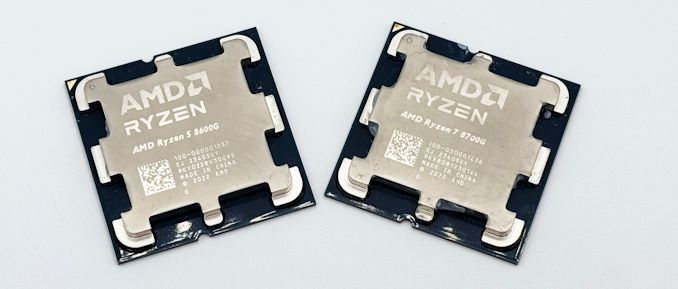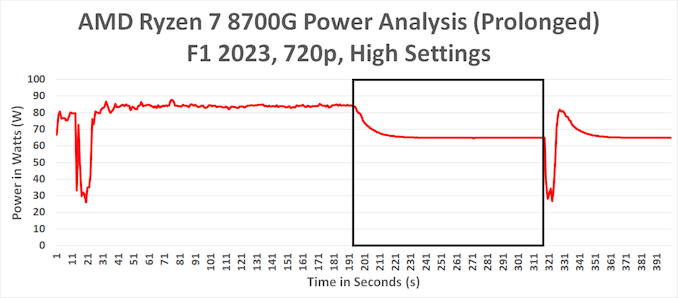AMD Set to Fix Ryzen 8000G APU STAPM Throttling Issue, Sustained Loads Affected
by Gavin Bonshor on February 2, 2024 11:30 AM EST- Posted in
- CPUs
- AMD
- APUs
- Phoenix
- 4nm
- Zen 4
- Ryzen 8000G
- Ryzen 7 8700G
- Ryzen 5 8600G
- STAPM

Earlier this week, we published our review of AMD's latest Zen 4 based APUs, the Ryzen 7 8700G and Ryzen 5 8600G. While we saw much better gaming performance using the integrated graphics compared to the previous Ryzen 5000G series of APUs, including the Ryzen 7 5700G, the team over at Gamers Nexus has since highlighted an issue with Skin Temperature-Aware Power Management, or STAPM, for short. This particular issue is something we have investigated ourselves, and we can confirm that there is a throttling issue within the current firmware (at the time of writing) with AMD's Ryzen 8000G APUs.
First, it's essential to understand what the Skin Temperature-Aware Power Management (STAPM) feature is and what it does. Introduced by AMD in back 2014, STAPM is a key feature within their mobile processors. STAPM extends the on-die power management by considering the processor's internal temperatures taken by on-chip thermal diodes and the laptop's surface temperature (i.e. the skin temperature). The primary goal of STAPM is to prevent laptops from becoming uncomfortably warm for users, allowing the processor to actively throttle back its heat generation based on the thermal parameters between the chassis and the processor itself.
This is where things relate directly to AMD's Ryzen 8000G series APUs. The Ryzen 8000G series of APUs is based on AMD's Phoenix silicon, which is already in use in their Ryzen Mobile 7040/8040 chips. Which means all of AMD's initial engineering for the platform was for mobile devices, and then extended to the Ryzen 8000G desktop platform. Besides the obvious physical differences, the Ryzen 8000G APUs feature a much higher 65 W TDP (88W PPT) to reflect their desktop-focused operation, making these chips the least power constrained version of Phoenix to date.
The issue is that AMD has essentially 'forgotten' to disable these STAPM features within their firmware, causing both the Ryzen 8000G APUs' Zen 4 cores and RDNA3 integrated graphics to throttle after prolonged periods of sustained load. As we can see from our investigation of the issue, in F1 2023 at 720p High settings, within 3 minutes of playing, we saw a drop in power by around 22%, which will undoubtedly impact both CPU and the integrated graphics performance during prolonged periods.
This directly affects the data in our review of the AMD Ryzen 7 8700G and Ryzen 5 8600G APUs, as the STAPM issues inherently mean that in very prolonged cases, the results may vary. Unfortunately, this issue apparently affects all AM5 motherboards and BIOSes currently available, so there's no way to properly run a Ryzen 8000G chip without STAPM throttling for the time being.
For the moment, we're putting a disclaimer on our Ryzen 8000G review, noting the issue. Once a fix is available from AMD, we'll be going back and re-testing the two chips we have to collect proper results, as well as to better quantify the performance impact of this unnecessary throttling.
Meanwhile, we reached out to AMD to confirm the issue officially, and a few minutes ago the company got back to us with a response.
"It has come to our attention that STAPM limits are being incorrectly applied to 8000 Series processors. This is causing them to drop their PPT limits under sustained load. We are working on a BIOS update to correct this behavior."
The fix that AMD will seemingly apply is through updated AGESA firmware, which, from their standpoint, should be simple in practice. Perhaps the biggest outstanding question is when this fix is coming, though we can't imagine AMD taking too long with this matter.
We must also thank Gamers Nexus for highlighting and providing additional context to the STAPM-related problems from which the Ryzen 8000G APUs suffer from. The video review from Gamers Nexus of the AMD Ryzen 7 8700G and Ryzen 5 8600 APU can be found above. Once a firmware fix has been provided, we will update our data set within our review of the Ryzen 7 8700G and Ryzen 5 8600G.











23 Comments
View All Comments
Samus - Friday, February 2, 2024 - link
Oops. :)drw392772 - Friday, February 2, 2024 - link
Thanks Steve!ballsystemlord - Friday, February 2, 2024 - link
Where is that quote that he likes to play from, anyway?kn00tcn - Saturday, February 3, 2024 - link
an apple or intel keynotethexile - Sunday, February 4, 2024 - link
Intel 2021 Keynote.https://www.youtube.com/watch?v=OnNZ3hCjIvs
ballsystemlord - Monday, February 5, 2024 - link
Thanks, thexile.thomasjkenney - Friday, February 2, 2024 - link
Good article, interesting find. Thanks."...problems from which the Ryzen 8000G APUs suffer from."
Avoids dangling participle, then swerves back for the hit! :)
mode_13h - Friday, February 2, 2024 - link
lol!FWhitTrampoline - Saturday, February 3, 2024 - link
"The Ryzen 8000G series of APUs is based on AMD's Phoenix silicon, which is already in use in their Ryzen Mobile 7040/8040 chips."And Ryzen 6000 series APUs that were Zen-3+/RDNA2 but had DDR5 Memory Controllers and yet there was no Ryzen 6000G for AM5 and no Ryzen 7000G for AM5 as well that's since been rebranded as Ryzen 8000G and too late to be attractive in pricing at its current MSRP versus a $100 dollar CPU paired with a low cost dGPU.
Had AMD released a Ryzen 7000G back then when dGPU prices where higher then it would have made more sense at a higher price point but not today and rebranded as 8000G at the 8700G's current MSRP. So now to wait for the retail pricing for the 8700G to drop below $200 and that will make more sense versus a $100 CPU paired with a low cost dGPU.
Dante Verizon - Saturday, February 3, 2024 - link
At current costs this certainly won't happen, but APUs will still be very popular for compact PCs. Mainly the 8600G which, once at the same clock rate, should have almost the same performance as the 8700G.